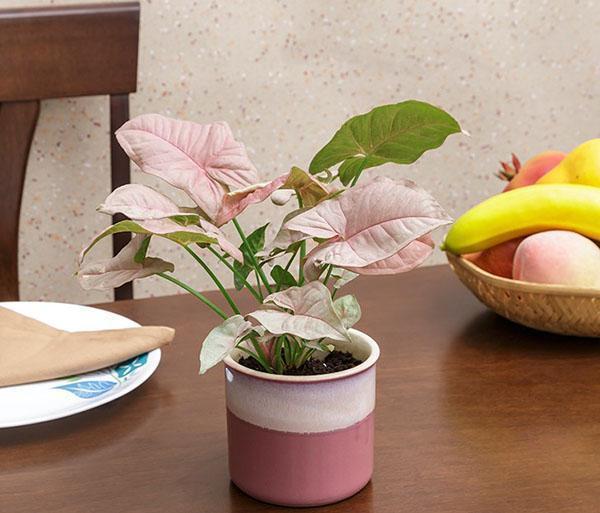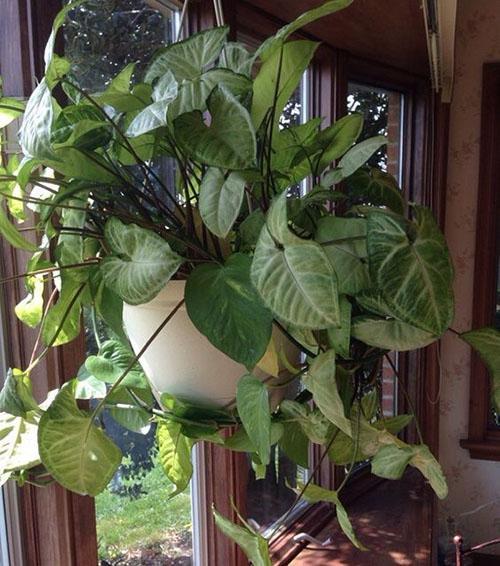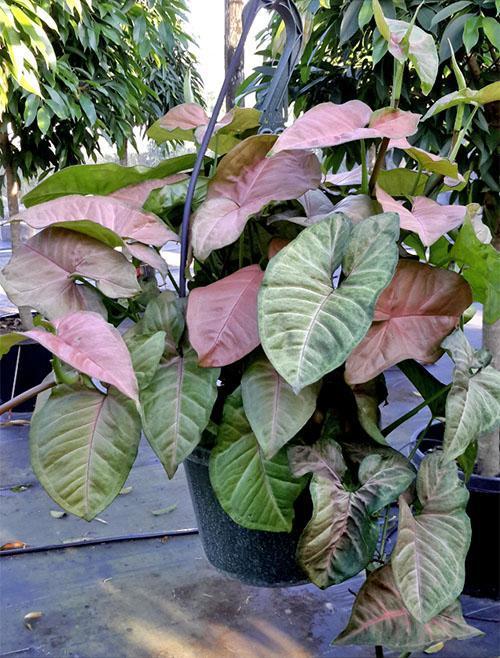Requirements for growing syngonium at home
 Syngoniums - strong, climbing vines with recognizable, like all chokeberry, arrow-shaped leaves, are desired by many flower growers. And how not to fall in love with syngonium, growing this luxurious flower at home does not require much effort, and the decorative effect is amazing!
Syngoniums - strong, climbing vines with recognizable, like all chokeberry, arrow-shaped leaves, are desired by many flower growers. And how not to fall in love with syngonium, growing this luxurious flower at home does not require much effort, and the decorative effect is amazing!
Features of care when growing syngonium at home
In nature, syngoniums live in tropical rainforests. Having the shape of a liana, plants perfectly use the opportunity to climb tree trunks to great heights. The numerous aerial roots that form above each internode not only help climb vertical surfaces, but also supply the stems and leaves with food and atmospheric moisture.
If you comply with the requirements of the syngonium for growing it at home, the flower responds with fast growth and beautiful foliage, which in most varieties has an original variegated color in green, silver, pink and purple tones. In nature, syngonium blooms, forming dense inflorescences-cobs of a greenish or yellowish hue, protected by crimson or white-pink bracts. However, when growing syngonium at home, very few amateur flower growers manage to see flowering.
Lighting for syngonium

But in winter, when daylight hours are reduced, such lighting for the syngonium is insufficient. This is expressed:
- in stretching internodes;
- in reducing the size of sheet plates;
- fading leaves.
For the cold season, it is better for the flower to choose a lighter place, protected from direct rays, or organize artificial lighting... Placing a pot on the south side does not at all satisfy the requirements of the syngonium when growing a house. Here, the plant quickly turns pale, loses foliage and may die.
Temperature and humidity for keeping syngonium
 The unpretentious, hardy syngonium takes root well at home and does not require maintaining a special temperature regime.
The unpretentious, hardy syngonium takes root well at home and does not require maintaining a special temperature regime.
In the warm season, the optimum temperature for keeping syngonium is 20-24 ºC. In winter, when active growth is slowing down, the room with the flower may be slightly cooler, but the temperature should not drop below 16 ºC.
However, it is unlikely that it will be possible to artificially reduce the temperature background in a residential apartment, and a working heating mercilessly dries the air. Therefore, in winter it is useful to use any available means of moisturizing, be it:
- electrical household appliances;
- pallets with expanded clay filled with water;
- irrigation of foliage with clean softened moisture.
 The same measures are taken in the summer heat. Increased air humidity for syngonium is the ability to more easily and without losses endure even serious temperature rises.
The same measures are taken in the summer heat. Increased air humidity for syngonium is the ability to more easily and without losses endure even serious temperature rises.
From spring to mid-autumn, it is useful to wipe the leaf plates with a damp cloth or sponge dipped in warm, settled water.
Syngonium watering rules
 Syngonium, like other inhabitants of the humid tropics, loves moisture. Therefore, the soil under the flower must be kept moderately moist, but not overly saturated with moisture.Are there more precise rules for watering syngonium? How to comply with the measure and not harm the plant?
Syngonium, like other inhabitants of the humid tropics, loves moisture. Therefore, the soil under the flower must be kept moderately moist, but not overly saturated with moisture.Are there more precise rules for watering syngonium? How to comply with the measure and not harm the plant?
Lack of moisture leads to the weakening and wilting of the flower, especially if the specimen growing at home is large. Excess water in the soil leads to acidification of the substrate, acidification of the roots and the aerial part of the plant.
To comply with the requirements of syngonium for growing it at home, the soil is often moistened, abundantly, but waiting for the soil surface to dry out. The sight flowing down into the pallet is drained. If the plant is kept in a winter garden at low temperatures, watering is reduced from autumn to spring. In room conditions, the need for water hardly changes.
Irrigation of the leaves is very important for ampelous syngonium plants, which receive water not only from the soil, but also from the air.
Transplantation, fertilization and soil selection for syngonium
 The syngonium needs a very loose, lightweight, moisture and air permeable substrate that could provide a rapidly growing culture with the necessary nutrition and conditions for the development of the root system.
The syngonium needs a very loose, lightweight, moisture and air permeable substrate that could provide a rapidly growing culture with the necessary nutrition and conditions for the development of the root system.
When choosing a soil for syngonium, you can stop at ready-made mixtures with a neutral or slightly acidic reaction. But many growers pick up the soil with their own hands, using:
- sorted peat;
- leafy ground;
- coarse sand;
- sphagnum;
- sod soil.
 The components are taken in equal proportions, mixed and, when growing syngonium at home, they are well heated in an oven or microwave oven. This measure will help protect the flower from the attack of soil fungi and pests.
The components are taken in equal proportions, mixed and, when growing syngonium at home, they are well heated in an oven or microwave oven. This measure will help protect the flower from the attack of soil fungi and pests.
At the time of planting a flower, it is useful to take care of support. It is strengthened deep in the drainage layer, then a layer of soil is poured on which a young plant or a transplanted adult specimen is placed.
The active growth of the flower needs regular support. In the warm season, the plant is fed every two weeks using liquid complex agents for decorative deciduous crops. Fertilizers for syngoniums should contain nitrogen, a complete set of trace elements with the exception of calcium.
When growing syngonium at home, you need to remember that the plant, like all chokeberries, is somewhat toxic. Contact with the skin or mucous membranes of caustic juice that appears when cutting stems and leaves can adversely affect health, cause pain in the eyes, burning, redness of the affected areas or allergic reactions.